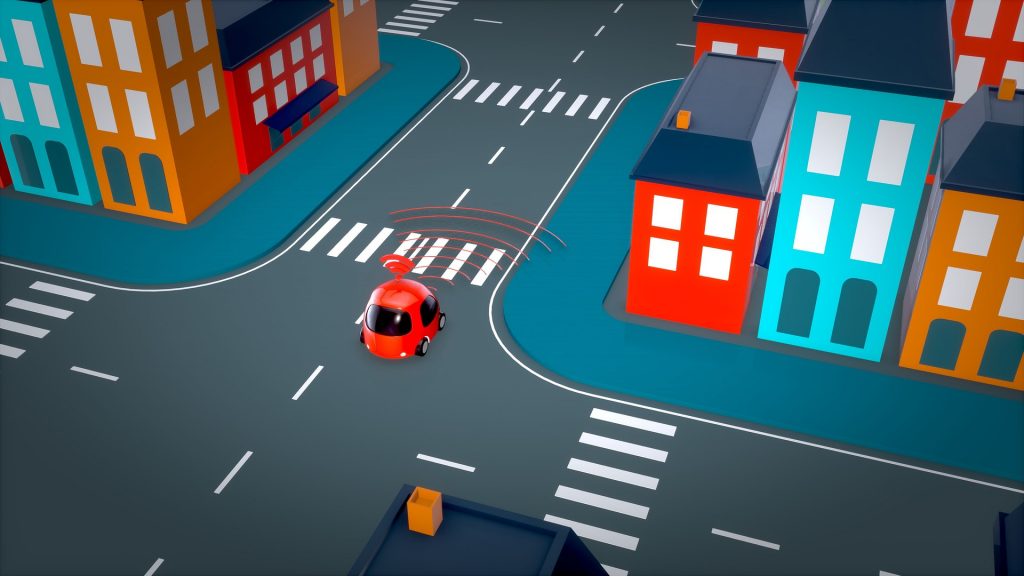Source: https://pixabay.com/illustrations/car-automobile-3d-self-driving-4343634/
Self-driving technology has taken the world by storm. With immense potential, this development could change the way we commute forever. The many benefits of self-driving vehicles include improved road safety, as well as more accessibility for disabled drivers. Considering this, pioneers in the autonomous vehicle field are working hard to make self-driving cars more mainstream. In this article, we cover the advantages and current trends in self-driving technology:
What is a Self-driving Car?
A self-driving car is an automated vehicle that runs by a combination of hardware and software programming. Using sensory data, it navigates different kinds of weather, traffic and road condition. As explained in an article on Simple Dollar, there are five levels of autonomous vehicles depending on the level of automation versus human involvement. Level 0 (human control, zero automation) to Level 5 (zero human control, full automation) covers the evolution of vehicles from human-driven to self-driven, using multiple systems like resolution sensors, GPS, cameras, and computation.
Self-driven cars use radar (relay of information through radio waves), LiDAR (mapping of surroundings through laser beams), ultrasonic sensors, computational units (like the NNA in Tesla’s FSD chip) and neural network algorithms (matrices designed to analyze and act upon non-programmed situations).
Safety Features and Benefits
Prominent surveys by the U.S Department of Transportation’s National Highway Traffic Safety Administration (NHTSA) reveal that most car accidents occur due to human error such as speeding and distracted and/or drunk driving. Considering this, it should not come as a surprise that a survey by TrueCar found that 90% of buyers of cars prioritize safety over other technological features. With this in mind, self-driving cars place a high emphasis on the integration of safety features.
Some of the most helpful features in avoiding a crash include rearview cameras, reverse backup sensors and provisions of blind-spot detection. Currently, an exit warning program is also being designed to help prevent accidents caused by swinging car doors.
According to the article by TrueCar, other safety features regularly available in semi-autonomous cars and highly recommended by buyers include parking assist, collision warning, lane departure warning, facial recognition software, automatic emergency braking, and thermal imaging to improve night vision.
The NHTSA believes that self-driving cars have the potential to significantly improve road safety. Because automated cars can remove human error from the equation; drivers, passengers, bicyclists, and pedestrians all stand to stay protected on the road. To quote the NHTSA, When you consider more than 36,560 people died in motor vehicle-related crashes in the United States in 2018, you begin to grasp the lifesaving benefits of driver assistance technologies.
Benefits for Drivers with Disabilities
Autonomous vehicles aspire to solve some of the hardships faced by disabled people due to a lack of accessible transportation. This is not unachievable, as demonstrated by a blind man who successfully completed a test ride conducted by Waymo in Austin by himself. Waymo is exploring ways to incorporate design elements for the disabled like an audible pickup signal, an information app and Braille control buttons for the visually impaired, and laptop-like screens that display traffic information to help the hearing impaired.
Currently, popular help features include folding ramps, rotating seats and guide rails for convenience of people who are mobility impaired. Instead of having to rely on others, those unable to drive can access such door-to-door services as facilitated by automation. Another means to make transportation inclusive is to provide for accessible parking by introducing handicap permits, placards, and license plates. Red (temporary disability), dark blue (permanent disability) and light blue (wheelchair user) placards designate parking spaces available to permit holders.
New Self-driving Technologies in Development
With the many benefits of self-driving technology, it is worth following all the new developments in this field. HIS Markit predicts that the sale of autonomous vehicles will reach 600,000 units by 2025 and 21 million units by 2035. International companies such as Ford, Mercedes, Tesla, and Alphabet are collecting massive amounts of data to update machine learning algorithms. These deep learning algorithms use convolutional neural networks, regression, pattern recognition and clustering to detect and classify objects as well as predict their movement.
Autonomous vehicle (AV) developers have also started to release and share their road-driving datasets, which should significantly contribute to research and innovation in self-driving technology. Sharing of driving scenarios also helps to improve automated driving systems (ADS) and thereby setting safety standards for AVs. This will hopefully improve public trust in self-driving systems, and make way for new regulations in regards to the same.
Currently, there is a consensus on two important parameters of evaluating self-driving programs miles a car drives (which establishes the credibility of an AV company) and disengagement human intervention in case the computer cannot handle a situation. The leading companies on this front are Waymo which drove 1.2 million miles in California with 0.09 disengagements per 1000 miles, and General Motors’ Cruise which drove half a million miles with 0.19 disengagements every 1000 miles.
That being said, there are many other companies that are actively investing in self-driving technology. Perhaps the most famous example is Amazon, with its experiments in autonomous package delivery. Companies like Audi, and even Apple, are all hopping on the autonomous technology bandwagon. Considering this, the future is likely to see some major improvements and upgrades to self-driving vehicles, in every possible way.
——
Self-driving technology has the potential to increase road safety and improve mobility of disabled passengers, as well as cut down on travel time, vehicular emissions and parking costs. Since the most important aspiration of self-driving technology is to eradicate human error in transportation, future developments must focus on updating vehicle software programming to mee this end so much so that an autonomous vehicle should not only deliver facilities that have been programmed into it but also identify and adapt to new situations. When self-driving cars are able to do this seamlessly, we are sure to experience a transportation revolution.
